AndroidStudio JNI +Gradle3.0 详解AndroidStudio JNI +Gradle3.0以上JNI爬坑之旅
KissDream 人气:01.首先什么是JNI呢?
JNI——(Java Native Interface),他是java平台的特性,不是安卓系统提供的。他定义了一些JNI函数,来让开发者可以通过调用这些函数来实现java代码调用C/C++代码。
2.如何使用JNI呢?
我们先将写好的C/C++代码编译成对应平台的动态库(windows是.dll文件,linux是.so文件)。
下面我们来举个栗子:使用AndroidStudio来实现JNI
3.要实现JNI先下载NDK,那么NDK又是什么呢?(面试宝典来了,赶紧掏出小本本)
- NDK是一系列工具的集合
- NDK提供了一份稳定、功能有限的API头文件声明
- NDK的发布,使“Java+C”的开发方式终于转正,成为官方支持的开发方式
- NDK将使Android平台支持C开发的开端
- 好,那接下来我们来下载NDK,有俩种方式:
- Google官方下载NDK:点击下载
- 通过SDKManager来下载NDK:
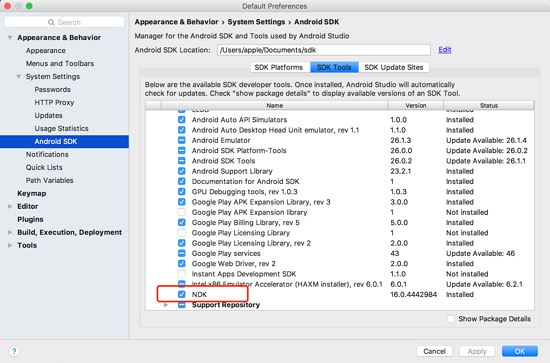
4.下来我们new一个新工程:这个工程只包含一个MainActivity
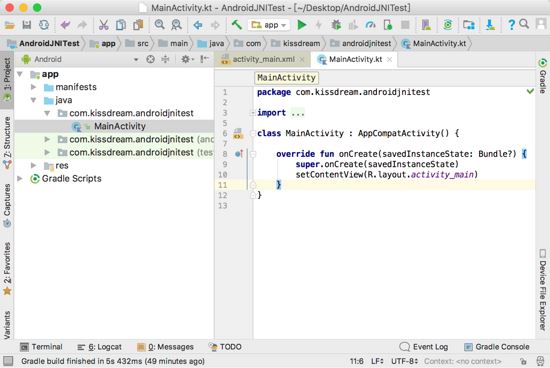
5.我们来检查一下NDK下载好了没有,怎么检查呢?如下:
检查SDK Location里面的NDK路径:

检查local.properties文件里面有没有NDK路径:
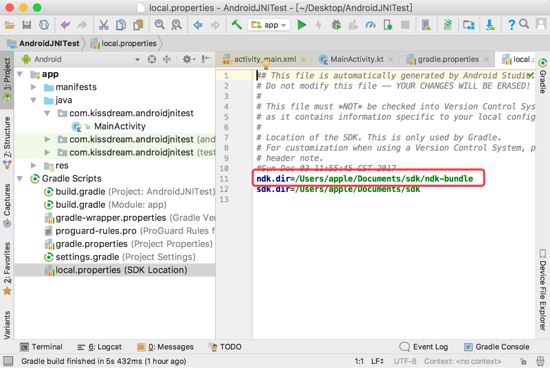
6.下来我们要编写JNI接口啦,如下:
JNI接口需要用native关键字修饰,我们会看到方法名报红,没关系,我们继续

7.我们先build一下工程,检查myJNIUtils.java编译后有没有生成class文件,在这个位置下:
AndroidJNITest/app/build/intermediates/classes/debug/com/kissdream/androidjnitest/myJNIUtils.class

8.使用javah生成.h头文件,具体如下:
打开Terminal,输入命令进入到debug目录下,命令如下:
cd/Users/apple/Desktop/AndroidJNITest/app/build/intermediates/classes/debug
然后使用javah+包名+文件路径来生成头文件,命令如下:
javah com.kissdream.androidjnitest.myJNIUtils
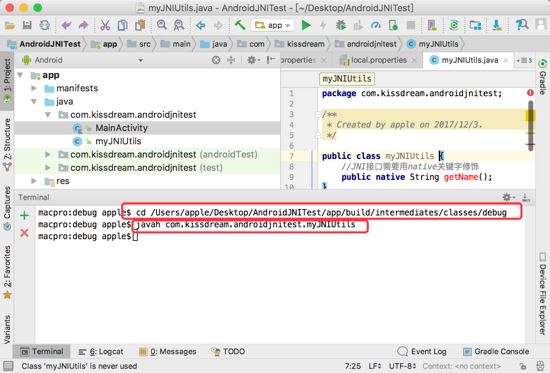
检查头文件有没有生成:
我们发现这个路径下多了个.h文件AndroidJNITest/app/build/intermediates/classes/debug/com/kissdream
哈哈,没错这个就是我们要生成的头文件
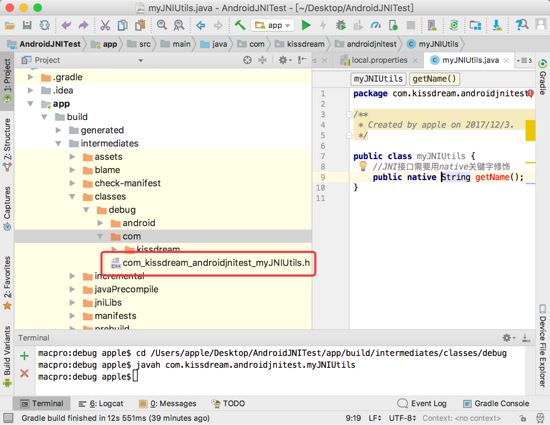
9.生成了.h文件还不行,只是声明了方法,我们还需要去实现它,那么如何去实现他呢,如下:
-我们在main下新建一个jni文件夹,如图:


.h文件内容如下:
/* DO NOT EDIT THIS FILE - it is machine generated */
#include <jni.h>
/* Header for class com_kissdream_androidjnitest_myJNIUtils */
#ifndef _Included_com_kissdream_androidjnitest_myJNIUtils
#define _Included_com_kissdream_androidjnitest_myJNIUtils
#ifdef __cplusplus
extern "C" {
#endif
/*
* Class: com_kissdream_androidjnitest_myJNIUtils
* Method: getName
* Signature: ()Ljava/lang/String;
*/
JNIEXPORT jstring JNICALL Java_com_kissdream_androidjnitest_myJNIUtils_getName
(JNIEnv *, jobject);
#ifdef __cplusplus
}
#endif
#endif
把生成的.h文件拷贝到jni文件夹下
在jni文件夹下,新建一个.c(c语言)或者.cpp(c++)的文件,来实现.h文件里声明的方法:
把.h文件里面声明的方法拷贝到新建的c++文件里面,然后在文件里面引入.h文件:
引入.h文件#include "com_kissdream_androidjnitest_myJNIUtils.h"
#include "com_kissdream_androidjnitest_myJNIUtils.h"
JNIEXPORT jstring JNICALL Java_com_kissdream_androidjnitest_myJNIUtils_getName
(JNIEnv * env, jobject obj){
//如果是用C语言格式就用这种方式
// return (*env)->NewStringUTF(env,"Kiss dream");
//如果是用C语言格式就用这种方式
return env->NewStringUTF((char *)"Kiss dream");
}
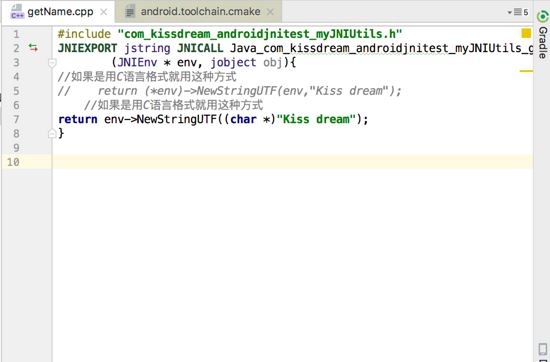
到这里我们的方法就实现完毕了
10.方法我们实现了,但是我们如何调用呢,不要着急,Follow me:
首先引入动态库:
public class myJNIUtils {
static {
//名字注意,需要跟你的build.gradle ndk节点下面的名字一样
System.loadLibrary("NameProvider");
}
//JNI接口需要用native关键字修饰
public native String getName();
}
NameProvider就是你要生成d的.so文件的文件名
下面我们来调用它
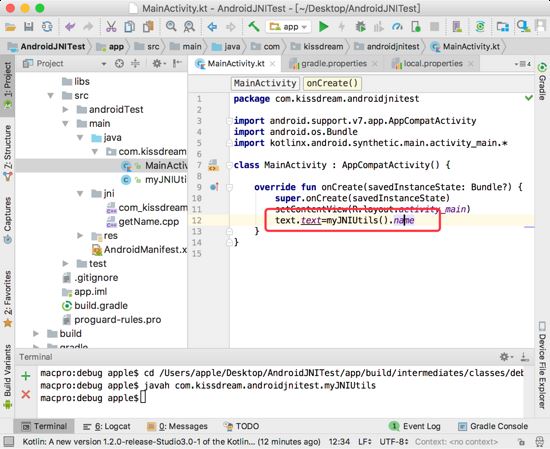
11.最重要的一步来了,生成so文件:
这个小编也不会,于是就去百度了下,得到结果:
在根目录gradle.properties下面加上:
android.useDeprecatedNdk=true意思就是允许使用低版本的NDK
在module下面的build.gradle下面加上ndk节点如下图:
ndk {
moduleName "NameProvider"
}
NameProvider注意这个名字要跟你引入动态库的名字一样
需要这俩步就可以运行生成so文件了
然儿,并没有想象的那么顺利,报错了,我顿时心中飞过一万只草泥玛,上log:
Error:Execution failed for task ':app:compileDebugNdk'. > Error: Flag android.useDeprecatedNdk is no longer supported and will be removed in the next version of Android Studio. Please switch to a supported build system. Consider using CMake or ndk-build integration. For more information, go to: https://d.android.com/r/studio-ui/add-native-code.html To get started, you can use the sample ndk-build script the Android plugin generated for you at: /Users/apple/Desktop/AndroidJNITest/app/build/intermediates/ndk/debug/Android.mk Alternatively, you can use the experimental plugin: https://developer.android.com/r/tools/experimental-plugin.html To continue using the deprecated NDK compile for another 60 days, set android.deprecatedNdkCompileLease=1512283120054 in gradle.properties
百思不得其姐啊,百度的答案大家都是这样做啊,为什么人家可以我的就不行呢,我的代码和他的一模一样啊
为什么人家可以我的就不行呢,我的代码和他的一模一样啊这句话作为程序员的我们很熟悉!难到我要放弃吗?no no no,作为程序员的我怎么能轻言放弃呢!每个人都有这样的经历,蓝瘦过、香菇过,到最后我们都找到我们的错误
来我们仔细看下Log,大概意思就是说:
- android.useDeprecatedNdk不再支持了
- 让使用CMake or ndk-build
- 然后还有链接
考虑使用CMake或ndk构建集成。要了解更多信息,请访问:
https://d.android.com/r/studio-ui/add-native-code.html
首先,您可以使用Android的ndk构建脚本示例插件为您生成:
/Users/apple/Desktop/AndroidJNITest/app/build/intermediates/ndk/debug/Android.mk
或者,你可以使用实验插件:
https://developer.android.com/r/tools/experimental-plugin.html
继续使用已弃用的NDK编译60天,设置
在gradle.properties
android.deprecatedNdkCompileLease = 1512283120054(这个测试不起作用)
经过各种查资料,发现原来在gradle3.0以上以前这种方法不在支持
学习过程就不详细描述了,直接上结果:
先通过SDKManager下载:CMake和LLDB
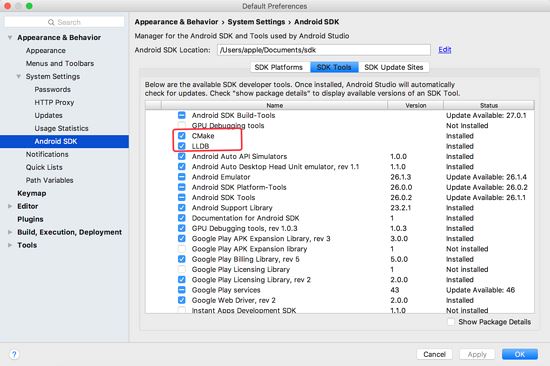
在build.gradle的defaultConfig节点下加入:
// 使用Cmake工具
externalNativeBuild {
cmake {
cppFlags ""
//生成多个版本的so文件
abiFilters 'arm64-v8a','armeabi-v7a','x86','x86_64'
}
}
在build.gradle的android节点下加入:
// 配置CMakeLists.txt路径
externalNativeBuild {
cmake {
path "CMakeLists.txt" // 设置所要编写的c源码位置,以及编译后so文件的名字
}
}

添加CMakeLists.txt文件到build.gradle文件同级目录下,具体内容如下:
# For more information about using CMake with Android Studio, read the
# documentation: https://d.android.com/studio/projects/add-native-code.html
# Sets the minimum version of CMake required to build the native library.
#CMakeLists.txt
cmake_minimum_required(VERSION 3.4.1)
# Creates and names a library, sets it as either STATIC
# or SHARED, and provides the relative paths to its source code.
# You can define multiple libraries, and CMake builds them for you.
# Gradle automatically packages shared libraries with your APK.
add_library( # Sets the name of the library.
# 设置so文件名称.
NameProvider
# Sets the library as a shared library.
SHARED
# 设置这个so文件为共享.
# Provides a relative path to your source file(s).
# 设置这个so文件为共享.
src/main/jni/getName.cpp)
# Searches for a specified prebuilt library and stores the path as a
# variable. Because CMake includes system libraries in the search path by
# default, you only need to specify the name of the public NDK library
# you want to add. CMake verifies that the library exists before
# completing its build.
find_library( # Sets the name of the path variable.
log-lib
# Specifies the name of the NDK library that
# you want CMake to locate.
log )
# Specifies libraries CMake should link to your target library. You
# can link multiple libraries, such as libraries you define in this
# build script, prebuilt third-party libraries, or system libraries.
target_link_libraries( # Specifies the target library.
# 制定目标库.
NameProvider
# Links the target library to the log library
# included in the NDK.
${log-lib} )
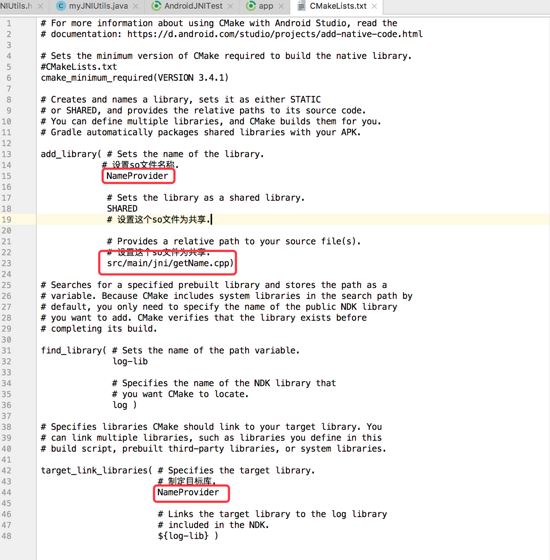
至此,我们所有的流程都做完了,下面来检查一下我们的成果,见证奇迹的时候到了:

可以看到我们已经成功生成so文件,再来上个效果图:

下载地址:点击下载Demo
加载全部内容